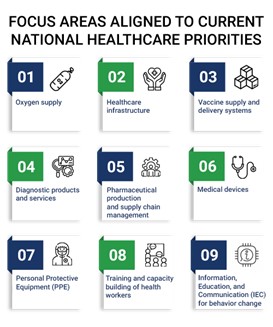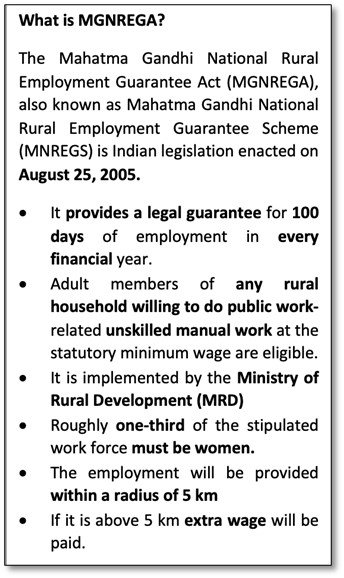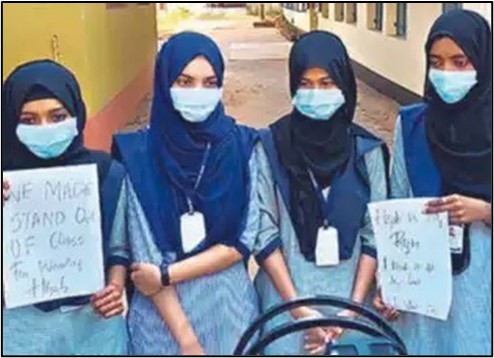Monday, 14th February 2022
Cross Border Insolvency - Edukemy Current Affairs
In News
The Economic Survey 2021-22 stresses on the need for cross border insolvency framework currently absent under the Insolvency and Bankruptcy Code, 2016 (IBC).
What is Cross Border Insolvency?
‘Cross-border insolvency’ denotes circumstances in which an insolvent debtor has assets and/or creditors in more than one country. Following aspects are involved in cross-border insolvency:
- Equal protection of the interests of domestic and foreign creditors.
- Safeguarding the value of the assets of a debtor, which are in different jurisdictions.
- Coordination and cooperation amongst courts and judicial authorities in various jurisdictions and the domestic laws applicable therein.
- Uniformity in the insolvency law and practices of different jurisdictions.
Current Mechanism and their shortcoming
In India, the primary legislation governing insolvency and bankruptcy is the IBC. Cross border insolvency is regulated by Section 234 and 235 of IBC.
- Section 234 empowers the Central Government to enter into bilateral agreements with other countries to resolve situations about cross-border insolvency.
- Further, the Adjudicating Authority can issue a letter of request to a court or an authority (under Section 235) competent to deal with a request for evidence or action in connection with insolvency proceedings under the Code in countries with the agreement.
Absence of standardized cross border insolvency framework creates complexities and raises various issues such as:
- The extent to which an insolvency administrator may obtain access to assets held in a foreign country.
- Priority of payments- Whether local creditors may have access to local assets before funds go to the foreign administration or not.
- Recognition of the claims of local creditors in a foreign administration.
- Recognition and enforcement of local securities, taxation system over local assets where a foreign administrator is appointed etc.
- Presently, while foreign creditors can make claims against a domestic company, the IBC currently does not allow for automatic recognition of any insolvency proceedings in other countries.
The extended insolvency proceedings of Jet Airways and the Videocon Group — two companies which had assets and claims from outside India — highlighted the need for enacting such a law.
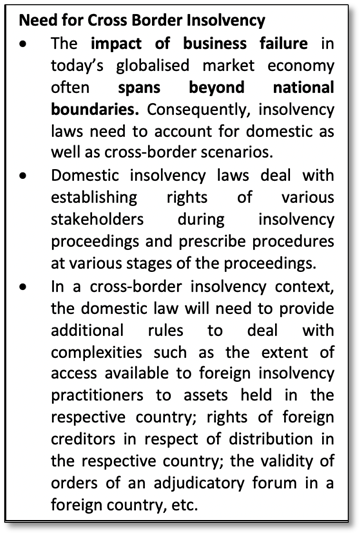
Steps Taken
- In an attempt to address the shortcomings of the present cross-border insolvency mechanism, India has released a set of draft guidelines containing a specific chapter on cross-border insolvency.
- The Insolvency Law Committee (ILC) in 2018 had recommended the adoption of the United Nations Commission on International Trade Law (UNCITRAL) with certain modifications. This law addresses the core issues of cross border insolvency cases with the help of four main principles:
- Access: It allows foreign professionals and creditors direct access to domestic courts and enables them to participate in and commence domestic insolvency proceedings against a debtor.
- Recognition: It allows recognition of foreign proceedings and enables courts to determine relief accordingly.
- Cooperation: It provides a framework for cooperation between insolvency professionals and courts of countries.
- Coordination: It allows for coordination in the conduct of concurrent proceedings in different jurisdictions.
Sources:
Credit rating agencies
In News
Ratings agencies have recently reported India as the most indebted emerging market with Budget 2022 not providing clarity on fiscal consolidation plans.
About the News
- The Rating agencies have commented on the increased budget for capital spending plans to a record 9% of the GDP with an ambitious borrowing plan and a target to reduce fiscal deficit level to 6.4%.
- Officials of Ministry of Finance has however accused ratings agencies of “double standards” when assessing emerging markets and developing economies.
- There are three prominent ratings agencies viz., Standard & Poor’s, Moody’s and Fitch which publishes reports which are studied by investors to gauge if they would get a return on their investment.
What are the major findings by rating agencies?
- Findings by Fitch:
- Sovereign rating: Fitch has put a negative outlook on India’s sovereign rating of BBB-, its lowest investment grade rating claiming that Budget was short on major growth-enhancing structural reform plans, had no new revenue generation ideas.
- Government debts: It has cautioned about India’s heightened general government debt levels The negative outlook on India can only be reversed if high growth can help claw back these debt levels.
- Findings by Moody’s:
- Fiscal challenges: Union Budget was growth-oriented, credit positive for many issuers but the budgetary provisions posed fiscal challenges. Focus on capital expenditure supports near-term growth but challenges long-term fiscal consolidation.
- Credit profile: Its Investors service termed the Budget a ‘credit positive’ for India’s sovereign rating but added that the path toward the Government’s medium-term deficit target is ‘undefined’, even as general government debt would increase to around 91% of GDP next year.
- Fiscal space: From a ratings perspective, India has limited fiscal space with the highest general government debt ratio among any similarly rated emerging markets.
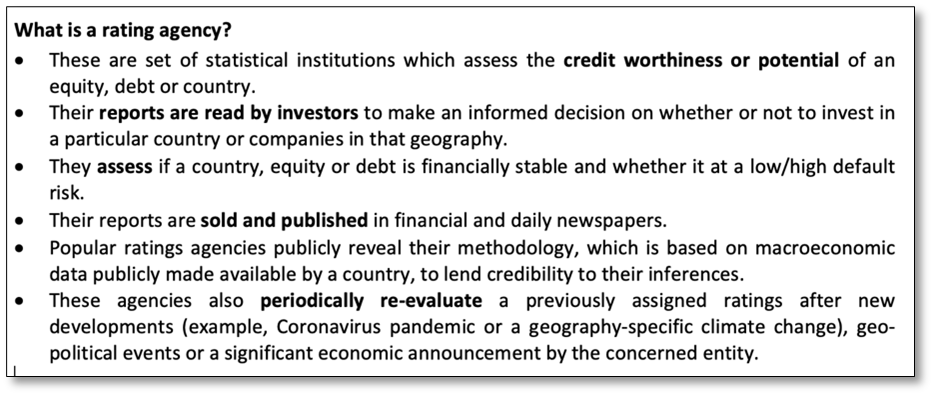
What are the concerns w.r.t rating agencies?
- Question on credibility: Credit rating agencies were subjected to severe criticism for allegedly spurring the financial crisis in the United States, which began in 2017.
- Error prone: These agencies are often charged for methodological errors and conflict of interest on multiple counts.
- Unreasonable at times: These agencies often underestimate the credit risk associated with structured credit products and fails to adjust their ratings quickly enough to deteriorating market conditions. For example, India’s proposed new tax on crypto assets has been considered a negative by global investors. Rating agencies can be unreasonable at times.
- Double standards: India having the highest debt among emerging economies, reeked of double standards since India’s debt to GDP ratio is far lower than the U.S., Japan, and other such highly rated countries in Europe, while its growth tends to be faster than them even in the worst of times.
- Misleading parameters: On its report on budget, While India’s public debt level at around 90% of GDP is less than Japan, where it is 256%, and the U.S. (133%). The more appropriate metric would have been debt to taxes ratio, which is extraordinarily high in India.
Why these ratings are important?
- Lowered rating of a country can potentially cause panic selling or offloading of investment by a foreign investor.
- Over reliance on credit ratings may reduce incentives for investor to develop their own capacity for credit risk assessment
Sources:
Nuclear Fusion Reactors
In News
A team at the Joint European Torus (JET) facility in England have managed to produce 59 megajoules of energy, which is the largest amount of energy produced so far from a nuclear fusion reaction, almost double of the 1997 record.
Nuclear Fusion Reaction
- Nuclear Fusion reactions, unlike Fission reactions occurs normally in nature. It powers the Sun and other stars.
- In a fusion reaction, two light nuclei merge to form a single heavier nucleus.
- Fusion can involve many different elements in the periodic table. However, researchers working on fusion energy applications are especially interested in the deuterium-tritium (DT) fusion reaction.
- Advantages of Fusion reaction over Fission reaction are:
- Fission produces many highly radioactive particles. Only a few radioactive elements are released in Fusion reactions.
- The energy released by Fusion Reactions are more than that of Fission Reaction. For example, forming a helium nucleus in DT fusion produces four times as much energy as is released during the fission of a uranium atom.
- Fusion uses inexhaustible, low-cost fuel, available worldwide, while Fission fuels are limited.
- In fusion there is no production of greenhouse gas, soot or acid rain, and no possibility of runaway reaction or meltdown that could pose a risk to public safety.
- Efficiency in a Fusion reaction can technically exceed a 100%.
- Despite these advantages, Fusion reactors have not yet been built for commercial use since fusion reaction needs very high temperature and high density of fuel.
- The JET (Joint European Torus), built in Oxfordshire, UK and ITER (International Thermonuclear Experimental Reactor), being built in Saint-Paul-lès-Durance, France are two international collaborations working on the development of Fusion reactors.
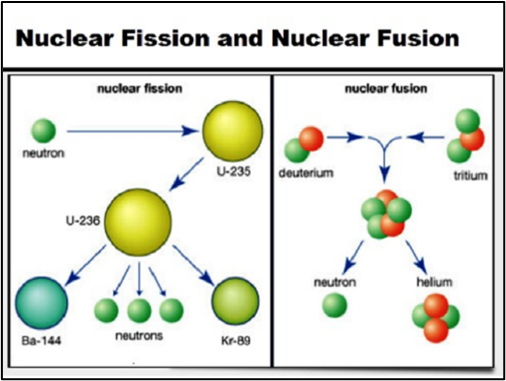
History of building a Fusion Reactor
- By the 1950s, researchers started looking at possibilities of replicating the process of nuclear fusion on Earth.
- And in 1950 soviet scientists Andrei Sakharov and Igor Tamm proposed the design for a type of magnetic confinement fusion device, the tokamak.
- This was followed, in 1951, by Lyman Spitzer's concept for the But tokamak system was a more efficient concept.
- European countries came together and began design work on the Joint European Torus, JET, in 1973. At JET, the largest operational magnetic confinement plasma physics experiment was held for the first time and the first plasmas were achieved in 1983.
- ITER was set in motion at the Geneva Superpower Summit in November 1985 for building a collaborative international project to develop fusion energy for peaceful purposes.
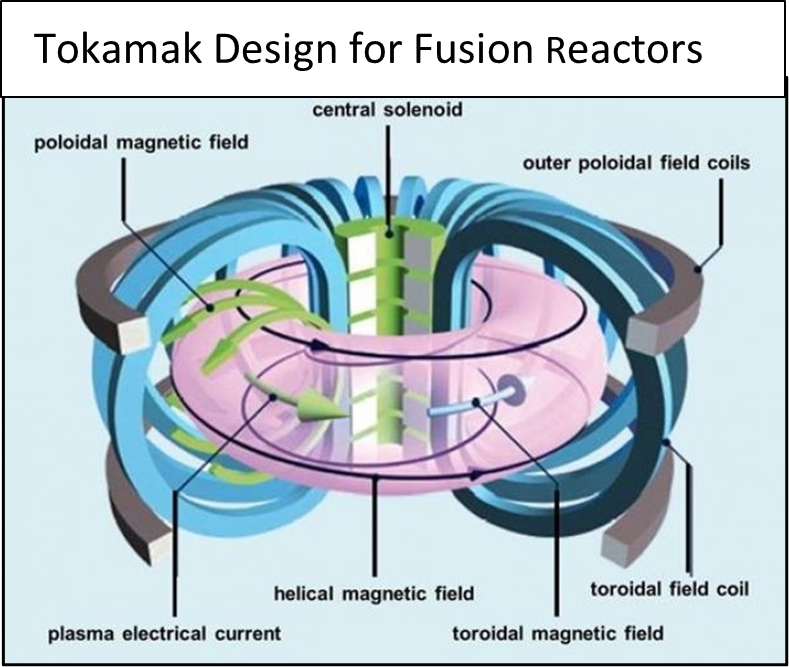
ITER
- The ITER (International Thermonuclear Experimental Reactor) is being built in southern France with the collaboration of 35 countries, including India which is one of the seven partners, alongside the European Union, the United States, Russia, Japan, South Korea and China.
- It is a technology demonstration machine which will produce only around 500 MW when operational. Nevertheless, it will enable the building of futuristic fusion devices that can be run as normally as the fission reactors today.
- According to the current timeline, it is expected to become operational only in 2035. Right now, the reactor is in the machine assembly phase.
- The Institute for Plasma Research in Ahmedabad, a laboratory under the Department of Atomic Energy, is the lead institution from the Indian side participating in the project.
- As a member country, India is building several components of the ITER reactor, while also carrying out a number of experiments and R&D activities related to the project.
Sources:
Launch of YouTube
On February 14, 2005 YouTube was launched by a group of college students. It was registered on February 14, 2005, by Steve Chen, Chad Hurley, and Jawed Karim, three former employees of the American e-commerce company PayPal. They had the idea that ordinary people would enjoy sharing their “home videos.” The company is headquartered in San Bruno, California. The American search engine company Google Inc. purchased YouTube for $1.65 billion in stock in November 2006. Rather than merging the Web sites, however, Google continued YouTube’s operation as before. YouTube allows users to upload, view, rate, share, add to favorites, report, comment on videos, and subscribe to other users. It offers a wide variety of user-generated and corporate media videos. YouTube earns advertising revenue from Google AdSense, a program which targets ads according to site content and audience.

Source:
Consumer Protection
In News
Consumer protection regulator CCPA has directed GlaxoSmithKline (GSK) Consumer Healthcare Ltd to discontinue advertisements of Sensodyne products in India for flouting norms.
About the News
- The CCPA held that the use of UK-based dentists by GSK to endorse their products was an attempt to circumvent the law as applicable to Indian dentists and give the impression that practicing dentists in the UK are recommending its product.
- Dentists practicing in India are not permitted to endorse any drug or product of the industry publicly under the Revised Dentists (Code of Ethics) Regulations 2014.
- Since dentists who are medical professionals qualified for treating dental health issues can be seen in the advertisement appreciating, recommending, and suggesting the use of the product, the advertisement gives the consumer an indubitable impression that if consumers do not buy the product, they are ignoring the advice of a dentist.
Who is a consumer?
- As per the Consumer Protection Act, 2019, a consumer is defined as a person who buys any good or avails a service for a consideration. It does not include a person who obtains a good for resale or a good or service for commercial purpose.
- It covers transactions through all modes including offline, and online through electronic means, teleshopping, multi-level marketing or direct selling.
- Consumer protection refers to the measures adopted for the protection of consumers from unscrupulous and unethical malpractices by the business and to provide them speedy redressal of their grievances.
- At the root of consumer protection is the recognition of an unequal relationship between consumers and producers.
Need for Consumer Protection
- Interconnected World: The growing interdependence of the world economy and international character of many business practices have contributed to the development of universal emphasis on consumer rights protection and promotion.
- Demand for Value for Money: Consumers, clients, and customers world over, are demanding value for money in the form of quality goods and better services.
- Expanding IT: With revolution in information technology newer kinds of challenges are thrown on the consumer like cybercrimes, which affect the consumer in even bigger way.
- Emerging complexities in Product Selling and Purchase: The growing size and complexity of production and distribution systems, the high level of sophistication in marketing and selling practices and in advertising and other forms of promotion, mass marketing methods and consumers’ increased mobility resulting in reduction of personal interaction between buyers and sellers, have contributed to the increased need for consumer protection.
- Consumer Satisfaction: Consumers’ satisfaction is the key to success of business. Hence, the businessmen should take every step to serve the interests of consumers by providing them quality goods and services at reasonable price.
- Principle of Social Justice: Exploitation of consumers is against the directive principles of state policy as laid down in the Constitution of India. Keeping in line with this principle, it is expected from the manufacturers, traders, and service providers to refrain from malpractices and take care of consumers' interest.
- Survival and Growth of Business: The business must serve consumer interests for their own survival and growth. Because of globalization and increased competition, any business organization which indulges in malpractices or fails to provide improved services to their ultimate consumer shall find it difficult to continue.
The Consumer Protection Act, 2019
The Consumer Protection Act, 2019 is governs the consumer protection in India through the following features:
- Central Consumer Protection Authority (CCPA): Under the Act of 2019, a CCPA was established with a view to regulate matters involving violation of consumer rights, misleading or false advertisements, unfair trade practices and enforcement of consumer rights. The Central Government appoints the members of the CCPA.
- Penalties for misleading advertisement: The CCPA may impose a penalty on a manufacturer or an endorser of up to Rs 10 lakh and imprisonment for up to two years for a false or misleading advertisement.
- Consumer Disputes Redressal Commission: Consumer Disputes Redressal Commissions (CDRCs) will be set up at the district, state, and national levels. Final appeal will lie before the Supreme Court.
- Jurisdiction of CDRCs: The District CDRC will entertain complaints where value of goods and services does not exceed Rs one crore. The State CDRC will entertain complaints when the value is more than Rs one crore but does not exceed Rs 10 crore. Complaints with value of goods and services over Rs 10 crore will be entertained by the National CDRC.
- Product liability: The Act has proposed provisions for product liability under which a manufacturer or a service provider must compensate a consumer if their good/service cause injury or loss to the consumer due to manufacturing defect or poor service. Product liability is now extended to service providers and sellers along with manufacturers. This means e-commerce sites cannot escape as aggregators anymore.
- Provision for Mediation: If the consumers wish to resolve the dispute outside the court, there is a provision for Mediation as well. The dispute can be referred to Mediation as an Alternative Dispute Redressal Mechanism.


Challenges in achieving the objectives of the Consumer Protection in India
- Lack of Awareness: The report by the CAG brought out that 66% of consumers were not aware of consumer rights and 82% were not even aware of the Consumer Protection Act. In rural areas, only 13% of the population had heard of the Consumer Protection Act.
- Overlapping Regulations: There is a multiplicity of regulatory/standardization/conformity assessment bodies and proliferation of certification and inspection bodies. There is no compulsion on the conformity assessment bodies, inspection bodies or laboratories to obtain accreditation, thus creating a lack of certainty about the existence of quality products, systems, inspections, and laboratories.
- Infrastructural Issues: Laboratory infrastructure is weak in terms of international norms. Quality professionals lack the skills to guide quality improvement efforts in industry. There is apathy among businesses towards standardization in general, and lack of awareness among them about the impact of standards on quality, competitiveness, and profitability.
- Absence for demand of Quality: There is absence of consumer demand for quality goods and services primarily because of lack of awareness among them regarding quality issues. As technical barriers to trade have become more significant as determinants of trade flows, urgent action has become necessary to correct the situation in the country as described above.
- Central Consumer Protection Authority: The 2019 Act leaves ambiguity as to how the CCPA will perform its functions and what methods will it adopt to achieve its functions. There is also no specification of qualification for the recruitment of the members of the CCPA.
- Further, the appointment of members of the CCPA by the Central Government will affect the independence of the authority. The consumer may be at a disadvantage in a dispute where the government has provided deficient services.
Way Forward
- Enhancing Consumer Awareness: There is necessity for continuing consumer awareness campaigns on a large scale to sensitize the population on basic aspects such as Maximum Retail Price (MRP), Gold Hall Marking, Indian Standard Institute (ISI) mark on products, and expiry dates.
- Consumer Protection for Services: For consumer protection, voluntary standards should be extended to the area of services, in particular, medical and hospital services, financing and investor services provided by non-banking financial companies, real estate services, e-commerce, and so on.
- National Standard System: The Bureau of Indian Standards (BIS) may be made the national standards body and repository of all voluntary national standards. Wherever voluntary standards are being formulated by other standards development organizations which are recognized as national (like Indian Roads Congress or Agmark), these may be published as national standards by BIS while these bodies continue to make these standards.
- Infrastructural Improvements: Setting standards is not enough for assuring the consumer of quality. For this, governments need to establish the full quality infrastructure, embracing standardization, conformity assessment and enforcement.
Question: Discuss the need for consume protections rights and the challenges in achieving consumer protection in India.
Source:
- Sensodyne asked to discontinue advertisements in India:
- Explained: Why the consumer protection body asked for Sensodyne ad to be scrapped:
- The Consumer Protection Bill, 2019:
- Consumer Protection Law In India:
- Consumer Protection and Competition Policy:
- Here's how consumers will benefit under the new Consumer Protection Act:
- THE CONSUMER PROTECTION ACT, 2019:
- CONSUMER PROTECTION:
- Consumer Protection:
The Registry Building
This is image of Registry Building in Chandernagore that is awaiting restoration for the past few decades. The Registry Building, a two-storied structure built in 1875 is a symbol of French settlement of the colonial town, Chandernagore. Chandernagore or Chandannagar was the first trading post on the eastern bank of the Hooghly, set up by the French in 1696. There are several buildings in the town that are a reflection of rich architectural heritage of the town. Other than the buildings and structures that have been given the heritage tag there was a total 99 Indo-French heritage structures have been identified (by the French) in Chandernagore that needs to be resorted.
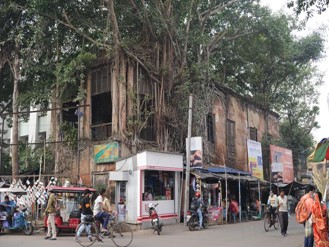
Source:
Air Sports
- Context: The Civil Aviation Minister has recently discussed about the draft National Air Sports Policy (NASP 2022).
- The term "air sports" covers a range of aerial activities such as air racing, human powered aircraft, hang gliding etc.
- They are a part of adventure sports that has gained popularity in India.
- Air Sports Federation of India (ASFI) would be the apex governing body. SFI shall be an autonomous body under the Ministry of Civil Aviation.
- Given the natural advantages of India, air sports has the ability to be financially sustainable on its own. The long term funding for development of air sports in India shall come from corporate investors, sponsors, membership fees, events and media rights.
- The coverage of NASP 2022 will include the following air sports: Aerobatics, Aeromodeling, Amateur-built and experimental aircraft, Ballooning, Drones, Gliding, Hang gliding and paragliding, Microlighting and paramotoring, Skydiving and Vintage aircraft
- The draft NASP 2022 policy aims to promote air sports in the country and to make India a global hub for air sports.
- The policy is in line with the Atmanirbhar Bharat Abhiyan as a part of which domestic design, development and manufacturing of air sports equipment will be promoted.
- India has the potential to be among the leading nations in the world of air sports. It has a large geographical expanse, diverse topography and fair weather conditions.
- Other than the direct revenue from air sports activities, the multiplier benefits in terms of growth of travel, tourism, infrastructure and local employment, especially in hilly areas of the country, are several times greater.
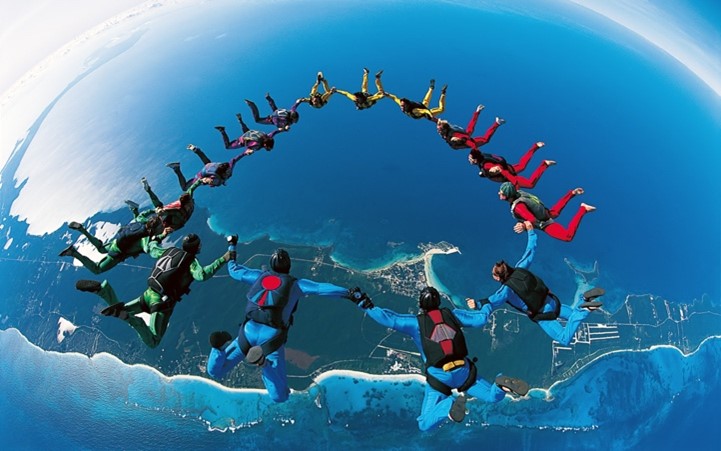
Source:
- Govt prepares draft NASP 2022 to promote air sports: Mos Civil Aviation
- The 5 Adventures Aero Sports In India
- DRAFT NATIONAL AIR SPORTS POLICY (NASP 2022):
Image source:
Self-Reliant India fund - Edukemy Current Affairs
- Context: As per the MSME Ministry, around 5,000 MSMEs are expected to benefit from the Self Reliant India (SRI) fund.
- SRI Fund is a SEBI-registered category-II Alternative Investment Fund (AIF) that will operate through mother-fund and daughter-fund structure.
- The government will be the sole anchor investor with the initial budgetary support of Rs 10,000 as the mother fund.
- Alternative Investment Fund (AIF) is a privately pooled investment vehicle that gathers funds from investors, including Indian investors and foreign investors to invest them under different categories of investments as specified by the SEBI for the benefit of investors.
- It is a fund of funds that invests in asset classes other than bonds, stocks and cash.
- SRI was announced 2020, which when operationalised, will make equity investments in MSMEs that will enhance their growth, listing on stock markets, and global expansion.
- Setting up an MSME fund in the name of SRI (Self-Reliant India) Fund would squarely address these challenges, give them a thrust to break their barriers, encourage corporatisation and allow them to grow to their full inherent potential.
- The Fund is an investment strategy of holding a portfolio of other investment funds, rather than investing directly.
- Setting up an MSME fund in the name of SRI (Self-Reliant India) Fund would squarely address challenges faced by MSMEs, give them a thrust to break their barriers, encourage corporatisation and allow them to grow to their full inherent potential.
- With government intervention, the SRI fund scheme would be able to channelize diverse variety of funds into underserved MSMEs and address growth needs of viable and high growth MSMEs.

Source:
- 5,000 MSMEs likely to benefit from govt’s Rs 50,000 cr Self Reliant India fund: Narayan Rane
- Alternative Investment Fund (AIF)
- Self-Reliant India (SRI) Fund:
Image source:
Koala Bears become Endangered
- Context: Australia has recently designated the koala as an endangered species.
- Koalas are arboreal herbivorous marsupials that inhabit the eucalyptus trees across Australian states of New South Wales, South Australia, Queensland and New South Wales.
- They are the globally recognised symbol of Australia's unique wildlife characterised by its stout, large head, tailless body, round & fluffy ears and large, spoon-shaped nose.
- Of late, the prolonged droughts, followed by the black summer bushfires, cumulative impacts of disease, urbanisation and habitat loss have been a great threat to the species.
- Because of this, the species which had been listed as “vulnerable” a decade earlier have been listed as endangered now.
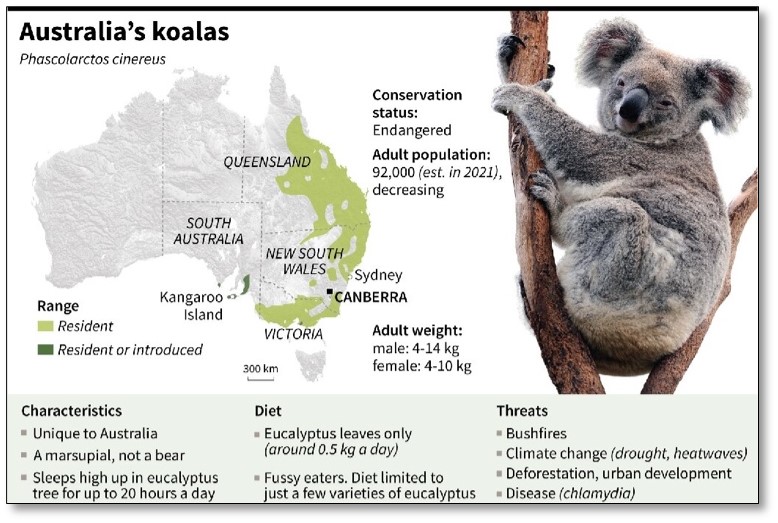
Source:
- Australia designates koalas as endangered species
- Australia warns koalas 'endangered' as numbers plunge
Image source:
Kaziranga-a net carbon emitter
- Context: As per the latest research of the Indian Institute of Tropical Meteorology, Kaziranga National Park has been releasing more carbon than it is absorbing.
- This is mainly due to decreasing rainfall in the region and most importantly, the unique soil of Kaziranga’s deciduous forest.
- The soil, which is home to a large population of bacteria releases carbon dioxide as they breathe, that adds to the carbon dioxide that is released by other organisms, including trees.
- Usually, a forest, or trees in a forest, take up carbon dioxide for photosynthesis and release carbon dioxide when they breathe.
- If the amount of CO2 taken up by a forest is more than the CO2 released by it through respiration, it acts like a carbon sink.
- Thus, forests act as carbon sinks and are globally promoted to counter the anthropogenic CO2 emissions.
- However, the photosynthetic activity of trees during the monsoon decreases due to increased cloud cover and hence, the ability of the forest to absorb CO2 also decreases which is the same during the post-monsoon and winter months, making the forest a net carbon emitter.
- This is the case with Kaziranga’s net emission.

Source:
Image source:
India’s semiconductor dream: TH
Essence: Total demand for semiconductors in India stands at $24 billion. This is expected to grow to $80-90 billion by 2030. Recent global disruption in the supply chain of semiconductors have underscored the point that increasing self-reliance in semiconductors is necessary for fulfilling the dream of Atmanirbhar Bharat. Though India has announced a $10 billion package to incentivize the manufacturing of semiconductors in the country, but more needs to be done.
India has a large and growing domestic market for semiconductors and we also are home to the largest number of chip designers outside of the US. This Semiconductor infrastructure needs to be assisted by the robust IPR protection regime, assured raw material supply, clustering of semiconductor fabrication plants and worker friendly working ecosystem.
Why should you read this article?
- To understand factors responsible for disruption in the global semiconductor supply chain.
- To appreciate steps taken by India to encourage semiconductor industries.
- To know what more steps India should take to become self-reliant in the semiconductor industry.
Source:
For ‘climate smart’ agriculture: IE
Essence: The article talks about the target set by India to become carbon neutral and the steps that it plans to take for it. The Union Budget has listed climate action and energy transition as some of the priorities and has also announced some concrete steps needed towards it. However, the government is failing to address the fact that it is the agriculture that contributes 73 per cent of the country’s methane emissions. Also, the steps that the government is taking to rectify this is not in tandem with the harm that the agricultural subsidies is causing. The loss is just not just environmental but financial too, with stock of grain pilling up above the buffer stock limit.
All this does not just reflect inefficient use of scarce capital, the amount of greenhouse gases (GHG) embedded in these stocks is also large. A study shows that one kg of rice emits 5.65 kg of carbon dioxide. According to the IMF, the world needs a carbon tax of $ 75 per ton by 2030 to reduce emissions. So, it’s high time for India to announce indicative carbon pricing and create a vibrant carbon market. Though India has achieved food security, now is the time to work towards securing the environment and groundwater. So, policies need to be revisited for India to move towards net zero agriculture and adopt climate smart agriculture in Amrit Kaal.
Why you should read this article?
- To understand the areas that contributes to emission in our country.
- To understand the steps the government has taken to address this problem
- To understand why India needs to revisit its policies to move towards net zero emission.
Sources:
How India’s Brahmos Deal Is Not Just About Philippines- ORF
Essence: The editorial talks about the multifaceted advantages of the Brahmos missile deal between Philippines and India. The deal contains three batteries of supersonic Brahmos- each battery would have two missile launchers, radar and command and control center along with training and logistics support. With this deal, Philippines would try to secure its west coast from regular challenges from Chinese Navy and coast guard.
The deal would further strengthen India’s defense export products in world market and increase demand amongst like-minded nations. It would also help in achieving India’s $5 Bn defense exports by the year 2025.
India has provided a line of credit to Philippines for the defense purchasal. This will help increase India’s strategic, financial and defense outreach amongst a wider group of countries in Indo-Pacific region.
Why you should read this article?
- To understand impact of defense deals amongst like minded nations.
- To know the multifaceted boost to India’s capabilities with such defense deals.
Source:
Knitted Knockers
Background
- Mastectomy (removal of breast) surgery can lead to loss of positive self-image and lead to problems like anxiety and depression.
- Knitted Knockers, a brand making crocheted prostheses started a journey for the survivors of breast cancer patient.

About the Knitted Knockers
- Jayashree Ratan from Mumbai witnessed the plight of the women who underwent the surgery in her near circles
- She understood that using silicon prostheses is expensive and unaffordable for the poorer sections of the society.
- She started making knitted or crocheted prostheses for these women who had undergone the surgery. The prosthesis and caps are all hand washable and can be used for up to two years.
- Online training on the sizing and standardization is provided to the volunteers for making the prosthesis and caps.
- Her organisation has created a network of over 270 volunteers from across India, UAE and the US who have distributed over 5,700 prostheses for free in the last four years.
Quote: “The most important thing in illness is never to lose heart.”—Nikolai Lenin
Source:
Share the article
Get Latest Updates on Offers, Event dates, and free Mentorship sessions.

Get in touch with our Expert Academic Counsellors 👋
FAQs
UPSC Daily Current Affairs focuses on learning current events on a daily basis. An aspirant needs to study regular and updated information about current events, news, and relevant topics that are important for UPSC aspirants. It covers national and international affairs, government policies, socio-economic issues, science and technology advancements, and more.
UPSC Daily Current Affairs provides aspirants with a concise and comprehensive overview of the latest happenings and developments across various fields. It helps aspirants stay updated with current affairs and provides them with valuable insights and analysis, which are essential for answering questions in the UPSC examinations. It enhances their knowledge, analytical skills, and ability to connect current affairs with the UPSC syllabus.
UPSC Daily Current Affairs covers a wide range of topics, including politics, economics, science and technology, environment, social issues, governance, international relations, and more. It offers news summaries, in-depth analyses, editorials, opinion pieces, and relevant study materials. It also provides practice questions and quizzes to help aspirants test their understanding of current affairs.
Edukemy's UPSC Daily Current Affairs can be accessed through:
- UPSC Daily Current Affairs can be accessed through Current Affairs tab at the top of the Main Page of Edukemy.
- Edukemy Mobile app: The Daily Current Affairs can also be access through Edukemy Mobile App.
- Social media: Follow Edukemy’s official social media accounts or pages that provide UPSC Daily Current Affairs updates, including Facebook, Twitter, or Telegram channels.

